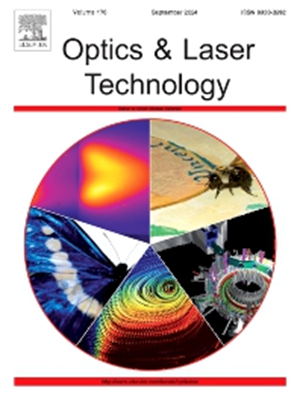Experimental investigation on crack evolution and separation strength in 4H-SiC slicing by sub-nanosecond laser
IF 4.6
2区 物理与天体物理
Q1 OPTICS
引用次数: 0
Abstract
Compared with wire sawing technology, laser slicing technology has been considered a more advantageous technique for slicing SiC wafers with the advantages of small kerf loss and high efficiency. How to realize laser slicing of SiC with low separation strength and low damage remains a current challenge. In this paper, semi-insulating SiC slices with a separation strength of only 0.04 MPa and a damage layer thickness of only 5 μm were realized using a sub-nanosecond laser. The crack nucleation mechanism was delved into by analyzing the morphology and composition of the modified layer, and the influence of laser processing parameters on crack propagation was systematically studied. Tensile tests were performed on samples with varying crack states to uncover the relationship between crack state and separation strength. The results indicate that the damage layer comprises graphite and amorphous silicon, with secondary processing being the key factor in the nucleation of cracks on the cleavage surface (0 0 0 1) plane. Separation strength minimizes when the interval matches the crack-tip stress field boundary. And the feasibility of large-area processing was verified on 6-inch ingots.
求助全文
约1分钟内获得全文
求助全文
来源期刊
CiteScore
8.50
自引率
10.00%
发文量
1060
审稿时长
3.4 months
期刊介绍:
Optics & Laser Technology aims to provide a vehicle for the publication of a broad range of high quality research and review papers in those fields of scientific and engineering research appertaining to the development and application of the technology of optics and lasers. Papers describing original work in these areas are submitted to rigorous refereeing prior to acceptance for publication.
The scope of Optics & Laser Technology encompasses, but is not restricted to, the following areas:
•development in all types of lasers
•developments in optoelectronic devices and photonics
•developments in new photonics and optical concepts
•developments in conventional optics, optical instruments and components
•techniques of optical metrology, including interferometry and optical fibre sensors
•LIDAR and other non-contact optical measurement techniques, including optical methods in heat and fluid flow
•applications of lasers to materials processing, optical NDT display (including holography) and optical communication
•research and development in the field of laser safety including studies of hazards resulting from the applications of lasers (laser safety, hazards of laser fume)
•developments in optical computing and optical information processing
•developments in new optical materials
•developments in new optical characterization methods and techniques
•developments in quantum optics
•developments in light assisted micro and nanofabrication methods and techniques
•developments in nanophotonics and biophotonics
•developments in imaging processing and systems

 求助内容:
求助内容: 应助结果提醒方式:
应助结果提醒方式:


